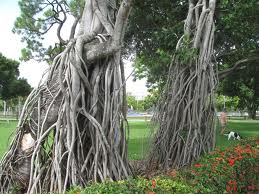 |
| A hòn non bộ in Duy Nghia (Quang Nam) |
In 1997, my family had to move out of the villa Mai-Phuong, a splendid villa shaded by an enormous mango tree and a row of coconut trees at the end of an alley, Nguyên Thông street, District 3, Saigon. The five-year lease had come to an end, and the usufructuaries of the villa (a couple who had participated in the war effort on the communist side) were thriving to get legal ownership so they could tear down the villa, divide the land into small plots and sell them. Back then, nobody bought architecture. People bought land. Constructible land. Garden space was worthless.
The villa was Sleeping Beauty's Manor when we signed the lease in 1992, refurbished it and moved in.
When it was time to move out, my (ex-) husband and I made appointments with a state-owned real estate company to visit houses for rent. The housing situation had opened up throughout the years and the choice was larger. That is, if you didn't expect a garden. The first house that was shown to us was such a gardenless town house. The entrance door had metal folding repellent doors that screeched. My stomach squirmed at the sound. We walked into the empty space, following the real estate agent who soon stopped at a small courtyard at the junction of the living-room and the staircase and emphasized what she thought was persuasive : 'A hòn non bộ.' I stared at the miniature landscape, the rock-shaped cement, the dry fishless tray, the pathetic miniature trees. Tears welled up and flowed. And flowed. I walked through the house tour sobbing.
 |
| Sometimes, ceramic figurines, ponds and temples adorn the trays |
There would be no further tours of rental houses. I decided to rent a floodable plot of land and build wild jungle bungalows on stilts.
If you still want a hòn non bộ after reading this, you need to abide by a set of designing rules. There are only eight proper positions of rocks: the lone peak, the twin peaks, the mountain range, the low mountain range, the giant vs. dwarf peaks, the (slanted) dragon peak, the mysterious cliff, the organic shape (suggesting an animal, a person).
 |
| A 'mountain range' in Duy Nghia (Quang Nam) |
 |
| Photo credit: Tropical Plants Library @ http://mgonline.com |
You will also need the cardinal ficus benjamina, a tree that grows to 30 m in height in the wild. Its aerial roots are impressive.
Rules are boring. Unless they have a structural raison d'être, such as rimes in a sonnet, rules limit scope. As tools of oppression, they lead to perversity, especially when associated with money. Another set of four rules (cổ, kỳ, mỹ, văn) commands the price of a tray: the age of the tree, its bizarreness, its beauty (whatever that means), and the overall style of the arrangement. A current hòn non bộ show at the Hanoi Museum exhibits specimens worth up to six million dollars*. In the more affordable one-million dollars range, a few smaller items are available.
In this perverse perspective, plants do not elicit consideration on their own. The blue-veined giant leaves of the curcuma zedoaria stir no aesthetic emotion. The palm-of-the-hand-sized canna lilies inspire no ecstasy. Both can be found on roadsides, growing spontaneously without being coaxed into shapes. They never get to age: each stem flowers only once. After flowering, they are trimmed down to their roots to make room for the suckers. They are bizarre enough (in my opinion), beautiful, stylish and free.
*Those who can read Vietnamese are invited to check this information at:
http://honnonbo.vn/cay-canh-dai-gia/270-ngam-cay-canh-trieu-do-mung-dai-le.html




